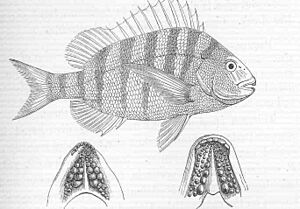Sheepshead facts for kids
Quick facts for kids Sheepshead |
|
|---|---|
 |
|
 |
|
| Conservation status | |
| Scientific classification | |
| Synonyms | |
|
The sheepshead (scientific name: Archosargus probatocephalus) is a cool marine fish. People also call it the sheepshead seabream or convict fish. It belongs to the family of fish called Sparidae, which includes seabreams and porgies. You can find this fish in the western part of the Atlantic Ocean. It's an important fish for both people who fish for fun and those who fish for a living.
Contents
Why is it Called a Sheepshead?
The sheepshead fish gets its name from its unique look. Its scientific name, Archosargus probatocephalus, actually means "sheep head." This is because the fish has some features that remind people of a sheep. For example, it has large teeth that stick out a bit when its mouth is open.
What Does a Sheepshead Fish Look Like?
Sheepshead fish have a body shape that is oval and flat from side to side. Their head is small and blunt, meaning it's not pointy. They have medium-sized eyes and a small mouth that opens horizontally.
Sheepshead Teeth and Fins
One of the most interesting things about the sheepshead is its teeth! The teeth at the front of its mouth are wide and flat. In its upper jaw, it has three rows of teeth that look like molars, similar to human teeth. These strong teeth help them crush their food.
The sheepshead has a long dorsal fin on its back. This fin has 12 stiff spines and 11 soft rays. Its anal fin on the bottom has 3 strong spines and 9 or 10 soft rays. The pectoral fins, which are like arms, are long. The caudal fin, or tail fin, is forked, like a "V" shape.
Sheepshead Colors and Size
Adult sheepshead fish are usually silvery or greenish-yellow. They might have an olive color on their upper body. They have 5 or 6 dark stripes that go up and down their sides. These stripes can fade as the fish gets older. Their tail and pectoral fins are greenish, while their other fins are dark.
Sheepshead fish can grow up to about 91 centimeters (3 feet) long. However, most sheepshead you see are usually around 35 centimeters (14 inches) long.
Where Do Sheepshead Fish Live?
Sheepshead fish live in the Western Atlantic Ocean. You can find them from Nova Scotia in Canada all the way down to Brazil. This includes the Gulf of Mexico and the Caribbean Sea.
Sheepshead Habitat
These fish love to live in coastal waters. They often hang out near rocky areas, jetties (long structures built into the water), and piers. You might also find them around mangrove roots and in tidal creeks.
Sheepshead can live in water with different salt levels. They prefer brackish water, which is a mix of fresh and saltwater. In winter, they sometimes go into freshwater areas, like rivers, to find warmer spots.
What Do Sheepshead Fish Eat?
Sheepshead fish are omnivores, meaning they eat both plants and animals. They are known for their strong teeth, which help them eat hard-shelled prey.
Sheepshead Diet
Larger sheepshead and young adults enjoy eating:
- Blue crabs
- Oysters
- Clams
- Other crustaceans (like shrimp)
- Small fish
They use their big, flat teeth to crush shells and scrape barnacles off rocks. Younger sheepshead, called juveniles, eat tiny animals called zooplankton and insect larvae.
Sheepshead Life Cycle
Sheepshead fish in the southern United States usually lay their eggs in early spring. The adult fish move farther out into the ocean to spawn (lay eggs). After spawning, they return to coastal waters and estuaries (where rivers meet the sea).
Young sheepshead fish are often found in sea grass beds or over muddy areas. Once they grow to about 50 millimeters (2 inches) long, they leave these areas. Then, they join the adult sheepshead fish.
Fishing for Sheepshead
Sheepshead fish are popular among fishermen because they are fun to catch. Since they eat shellfish, the best baits to use are:
- Shrimp
- Sand fleas (also called mole crabs)
- Clams
- Fiddler crabs
- Mussels
Sheepshead are very good at stealing bait, so you need a small hook to catch them!
Where to Find Sheepshead for Fishing
If you're fishing from a boat, it's not hard to find sheepshead. Fishermen look for places with rocky bottoms or structures in the water. This includes jetties, bridges, and pier pilings.
Sheepshead usually weigh between 1.4 to 1.8 kilograms (3 to 4 pounds). But some can grow much bigger, reaching 4.5 to 6.8 kilograms (10 to 15 pounds)! In the past, too many sheepshead were caught. Now, they are becoming more important for commercial fishing in the Gulf of Mexico. This is because other popular fish species have become less common.
Sheepshead Bay
Did you know there's a place named after this fish? Sheepshead Bay, Brooklyn in New York City got its name because sheepshead fish used to be found in its waters.


